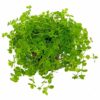Microsorum pteropus is a 15-30 cm tall Asian water fern. To be grown on a root or stone and attached with fishing line until established. Covering the rhizome if planted in the bottom will cause it to rot. Splitting the horizontal rhizome makes it simple to propagate. A tough plant that thrives in any environment. The black spots beneath the leaves are sporangia (reproductive organs), not disease, as many people believe.
Microsorum Pteropus has deep green leaves and grows to be about 13″ inches tall, but it can grow to be nearly 3′ feet tall in the wild. Because of its height, it makes an excellent background plant for an aquarium. If you plant it too close to the front, it will block your view. Its height makes it a good choice for a pond plant because the leaves will grow above the level of the water in an outdoor setting, creating an interesting display.
Flowering and fragrance: The plant has leaves, a rhizome, and a root system, but no flowers. The roots are very thin and dark brown, suited to clinging rather than nutrient uptake. The root system is made up of very fine, hair-like tendrils that form a strong tangle around whatever they choose to anchor to. A rhizome is found at the plant’s base and is responsible for nutrient absorption. When the plant’s roots are firmly attached to an object, the rhizome will begin to grow and will eventually cover the object. Rhizomes in the wild can spread to 6″ inches across. The leaves are dark green, leathery, and tough. These two characteristics make them an excellent choice for an aquarium or pond filled with herbaceous fish such as koi and goldfish. The Java Fern requires little light. It cannot tolerate extremely bright aquarium lights or prolonged sun exposure.
This is a tropical plant that thrives in temperatures ranging from 70° to 75° F (21° to 24° C), but it can tolerate temperatures as low as 60° F (15° C) and as high as 83° F (28° C).
This plant is native to freshwater, but it can tolerate salty water. This plant prefers pH levels ranging from 6 to 7.5. You must maintain a very high level of humidity if you keep your plants in a setting where the leaves will grow out of the water.
Planting Java Fern is simple; simply immerse it in water. Even if you just drop it in, it will begin to grow. The Java Fern will thrive while floating, or it may be able to attach to something that its roots can hold onto. You can also direct its placement by burying the roots in gravel or tying it to a piece of wood, rock, or other décor. Super glue gel is my preferred method for planting Java Fern. Simply take the piece of décor to which you want to glue the fern and make a simple bead of glue. Hold it against the glue for 30 seconds before letting it air dry for 3 minutes. Place it in the tank and observe its growth! The only thing to watch out for is not burying the rhizome (the twig like portion of the plant). All of the roots and leaves grow from this rhizome. It will rot if it is buried under gravel or sand. This plant has the advantage of not requiring substrate, making it ideal for bare bottom tanks.
Assuming you’ve planted it and are providing it with light, your Java Fern will begin reproducing soon. At the edges of the leaves, tiny Java Ferns grow. When they reach maturity, they drop off and attach themselves to wherever they land. You can also break off leaves and float them in the aquarium. The plant even has a backup plan: if it starts to die, it immediately produces new plantlets, sometimes as many as 20 per leaf. This is an excellent method for preparing a new tank or propagating it to give to a new fish friend.









